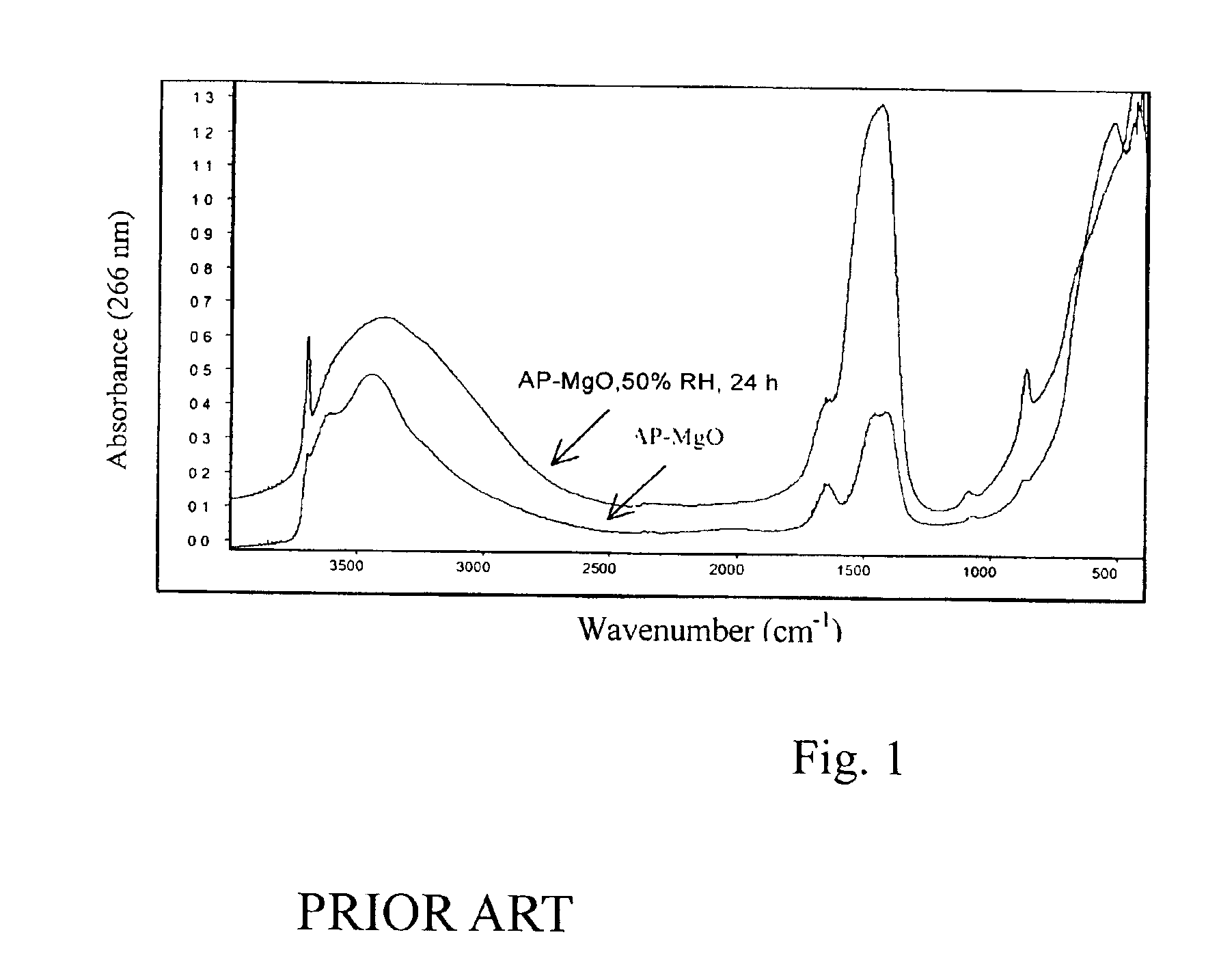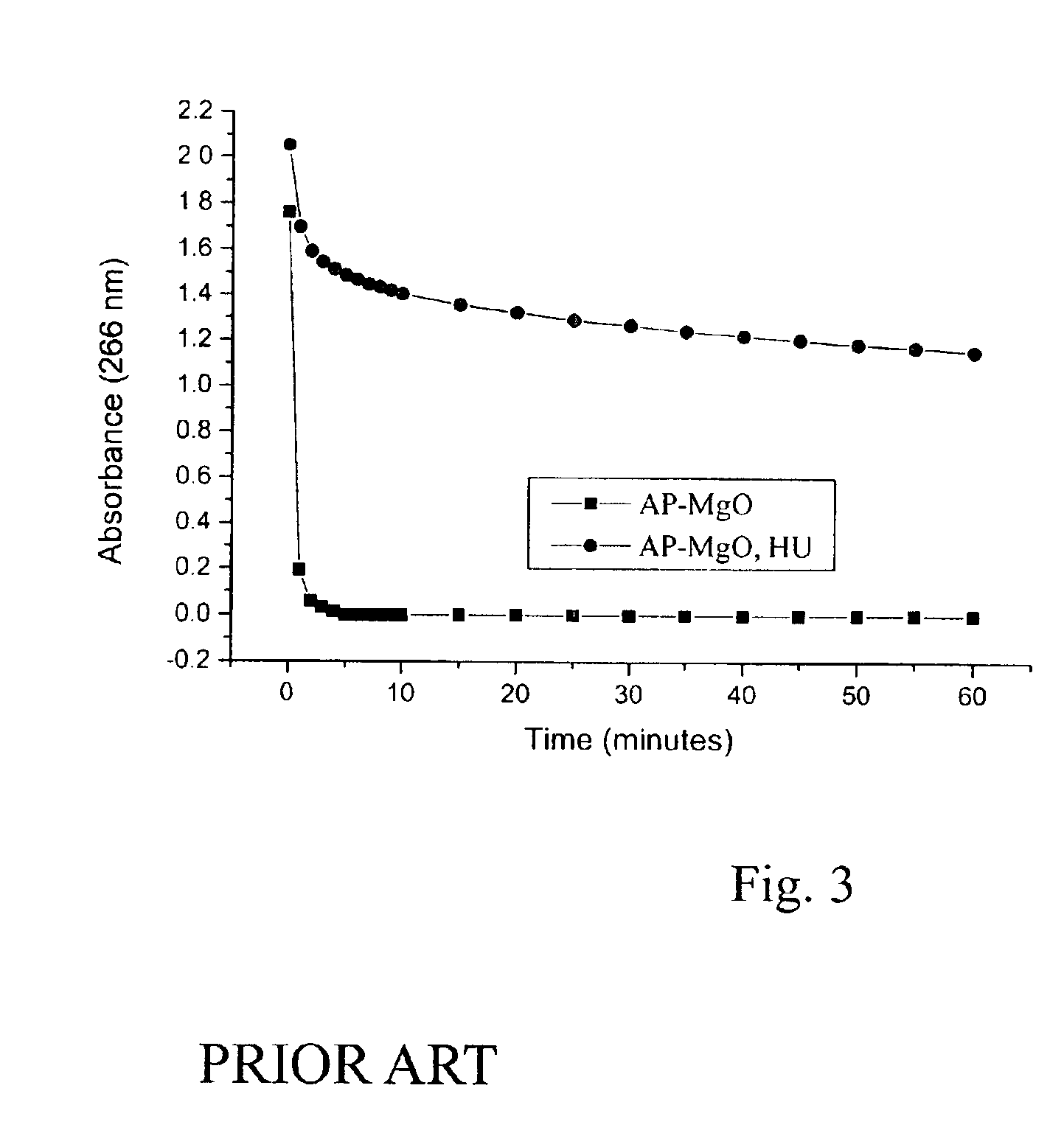Air-stable metal oxide nanoparticles
- Summary
- Abstract
- Description
- Claims
- Application Information
AI Technical Summary
Benefits of technology
Problems solved by technology
Method used
Image
Examples
example 1
Magnesium Oxide Nanoparticles Coated with a Surfactant
1. Preparation of Materials
Several 1 g samples of magnesium oxide nanoparticles were individually coated with from 1-20% by weight of a hydrocarbon-based surfactant. This was accomplished by adding the magnesium oxide nanoparticles and the desired surfactant to a 250 mL, stoppered Erlenmeyer flask equipped with a stir bar and containing 50 mL of hexanes. The reaction mixture was stirred for 20 hours followed by centrifuging and drying in an oven 110° C. for one hour. The resulting samples were characterized by BET and XRD. The BET multi-point surface area was determined using N2 adsorption at liquid N2 temperature to measure the surface area / unit mass. The BET surface area measurement techniques are described in Introduction to Powder Surface Area, Lowell, S., John Wiley & Sons: New York (1979), incorporated by reference herein. Table 1 sets forth the results of this analysis, along with the particular surfactants that were used....
example 2
Magnesium Oxide Nanoparticles with Double Surfactant Coating
1. Materials and Methods
This procedure was carried out to determine whether the use of a double surfactant coating would improve on the results obtained in Example 1 above. In this procedure, 1 g of magnesium oxide nanoparticles and the desired surfactant were added to a 250 mL, stoppered Erlenmeyer flask equipped with a stir bar and containing 50 mL of hexanes. The mixture was stirred for 20-24 hours after which a second surfactant was added followed by further stirring for another 20-24 hours. The reaction mixture was then centrifuged and dried in an oven at 110° C. for 1 hour. BET multi-point surface area and XRD measurements were taken of the resulting samples. These results are shown in Table 3.
TABLE 3 Weightgain uponSSA, m2 / gXRD patternhumiditybeforeafterbeforeafterEntrySurfactantexposure %humidityhumidityhumidityhumidity1AOT / DeZOLINE T nda32360.0oxideoxide2AOT / Surfynol 104A2633080.9oxideoxide3DeZOLINE T / AOTnd30860.7o...
example 3
Magnesium Oxide Nanoparticles Coated with Oil
1. Materials and Methods
In this procedure, respective samples of dry magnesium oxide particles (3.0 g) were mixed with 50% by weight of vegetable oil or mineral oil by mixing in a plastic cylindrical container. Mixing was carried out with a Dispermat mixer (about 600 rpm for about 1 minute, mixing with a spatula, then about 800 rpm for about 1 minute). The samples were then exposed to humidifying conditions following the procedure described above. The humidified samples were analyzed for weight gain as well as paraoxon reactivity (see Table 4).
TABLE 4 Weight gainupon humidityHumidityUV absorption readingEntryAdditiveexposure %exposure0.5 h2 h20 h1None67No000Yes1.781.651.312Mineral Oil38No000Yes0.330.1603Vegetable Oil26No1.721.500.63Yes1.961.971.45
Both the vegetable oil and mineral oil resulted in an appreciable reduction in weight gain upon humidity exposure. While the vegetable oil-coated samples reacted poorly with paraoxon both before ...
PUM
| Property | Measurement | Unit |
|---|---|---|
| Size | aaaaa | aaaaa |
| Nanoscale particle size | aaaaa | aaaaa |
| Specific surface area | aaaaa | aaaaa |
Abstract
Description
Claims
Application Information
 Login to View More
Login to View More - R&D
- Intellectual Property
- Life Sciences
- Materials
- Tech Scout
- Unparalleled Data Quality
- Higher Quality Content
- 60% Fewer Hallucinations
Browse by: Latest US Patents, China's latest patents, Technical Efficacy Thesaurus, Application Domain, Technology Topic, Popular Technical Reports.
© 2025 PatSnap. All rights reserved.Legal|Privacy policy|Modern Slavery Act Transparency Statement|Sitemap|About US| Contact US: help@patsnap.com



